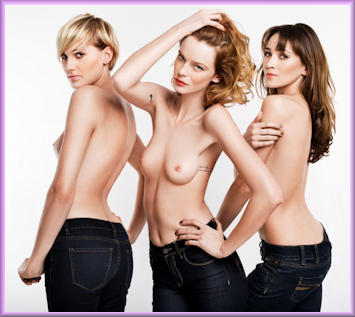
Question: One of these models was born 'male' and is transgender.
Which one? |
Origins
In
the late 1990's I saw several quizzes on the now defunct Geocites
hosting service about "passing" as a woman.
Unfortunately, they seemed to be mostly concerned with transvestites.
After
I transitioned, I
started in 2001 to develop a quiz for adult (age 18 or older)
transsexual women who were considering transition. The quiz
was intended to give some indication of their chances of passing or
being quickly "read" based primarily on physical appearance. It
was not intended to provide an indication about their chances of
passing consistently long-term (e.g., at work) when many other hard to assess factors come in to play,
such as dress sense, posture, mannerisms and social skills.
The quiz was
also intended to be thought provoking for the participant, rather than a serious and accurate assessment tool.
It proved to be surprisingly
difficult to develop the quiz as I quickly encountered multiple
difficult to resolve challenges. I finally decided that
"passability" depended predominantly on eight key criteria:
|
Voice
Age
Height
Facial appearance
|
Size of hands and feet
Overall physique and build
Head hair
Breast size and appearance
|

Passing ... passing ... and then she speaks. |
SRS/GCS was excluded due to being limited to intimate situations.
Everything else was either a minor attribute or a sub-category.
The quality of any feminisation surgery was inherently built
into these criteria, as was years on hormones although this was
initially scored.
The first version
of the quiz became very popular, although I was
aware that it had many limitations.
Voice
A big problem I encountered was how to include "voice" into the quiz.
The brutal reality is that a masculine voice is often a
showstopper for passing.
Many transwomen of
a very feminine appearance have a huge problem with their voice,
e.g., when answering the phone.
The vast majority
of transgender women with a voice that's consistently identified by
strangers as being "female" began taking hormones or puberty
blockers at an early age (13 or less), and so their voice never
'broke'.
Vocal training can help, but rarely enough. Surgery on the voice box (laryngoplasty)
is a drastic, expensive, and not always successful option.
Given all the problems, I removed "voice" entirely from
later versions of the quiz and
left it as an external potential show-stopper.
|

It's much
easier to pass if you are (left) a petite 115lbs:
"being only 5'4" really made my transition much easier...".
But if you are 6' tall and wear size 10
shoes (right), then youth, hormones and surgery seem
vital to pass consistently |
Age, Height and Hormones
In the first (2001-2) versions of the quiz I gave high weightings
to age and height, with years on
hormones also scored. I.e. a young transwoman of midest
height who had been
on hormones for several years was awarded a far higher score than an older
and taller woman who had just started hormones. This caused a
lot of complaints, a typical (paraphrased) email being:
"I'm age 54 and 6' 1" tall, according
to your quiz I have no realistic chance of passing. However, I
transitioned last year and know for a fact that I pass convincingly
as an attractive woman. Your quiz is clearly wrong.
I thus tweaked the scores, and tried to allow for situations
such as a tall 20-year old transwoman who had been taking
hormoines since age 14 becoming the 'next top model'.
Nevertheless, the negative feedback continued and
with considerable reluctance I removed
all scores directly related to age and hormones.

Four transgender
women.
But very different in terms of height, facial appearance, voice,
bust, shoe size, build, ... - and public familiarity. |
Familiarity
In recent years a vastly increased public awareness of
gender identity conditions has - for good and bad - made people far more
aware of transsexual indicators, and thus successfully passing
has become harder than ever. Further, the rapid growth in
the number of transgender people means that almost everyone now knows
someone who is transgender.

Question: Which one of these models was born 'male' and is transgender? |
In the 1990's a rather masculine
looking woman would be given the benefit of the doubt, twenty years
later people are much quicker to leap to the conclusion that she might
be transgender. The signs that are being subconsciously being examined have
gradually moved on from major indicators such as voice, height, and shoe size, to
more subtle indicators such as jawline, finger length, and scalp hair.
|

Question: Cis female, transwoman,
gay man? ...
The photo is of Prof. Kathleen Stock, who has faced abuse for expressing supposedly transphobic views. |
As result, with each iteration of the quiz I had to include yet
more attributes. These were often interlinked or even
contradictory, for example short blond hair can emphasise the
femininity of some faces, whilst long dark hair works much
better for other women. Another example is that long legs are attractive when young, but a modest height will
always greatly assist passability at any age.
The End (Almost)
From the beginning the quiz had subjective element, but it also had
a core of hard facts such as age, height, shoe size and figure.

Question: Which of these young women was born 'male' and is transgender? |
After feedback (often harshly worded) I downgraded
or removed these criteria but despite years of effort I have since
found it impossible devise a revised quiz that when tested I
consider having a reasonable degree of accuracy and fairness.
In 2017 I arrived at the conclusion that it was
impossible to incorporate all the complications into a static quiz
and therefore
have deleted the quiz from this page.
What is required is a
dynamic quiz
with many complex rules, linkages and dependencies built-in,
ideally including the use of Artificial Intelligence to assess photos,
videos and voice clips based after being trained using millions of
examples. The restoration of considerations such
as age and stature are probably also essential. Sadly,
constructing such a quiz is beyond my skills, although I would be happy to
contribute
and make constructive suggestions to anyone who wants to take on
such a project.
A
Corollory
After I gave up on my quiz, I realised that some medical papers
were essentially attempting the same difficult task, i.e. judging the
appearance and passability of a
male-to-female transwoman.
The two scales
below are based on
extracts from these - in particular
Body Satisfaction and Physical Appearance in Gender Dysphoria,
published in 2015 by
Tim C van de Grift and collaborators. The criteria
listed in these two scales are restricted to physical
characteristics, however some of studies used scales that
included or considered criteria such as age, sexual orientation,
education, job, and social role - all of which I had excluded
from my quiz after complaints.
Body Image Scale
Back in
1975,
Lindgren and Pauly proposed a
Body Image Scale (BIS), with subscales for primary sex characteristics, secondary sex characteristics, and neutral characteristics.
Additional subscales have since been added to allow for comparisons per body area,
as shown in the table below. The Cronbach alphas
(α) on the subscales give an indication of the subscales consistency and
reliability, 0.0 being useless and 1.0 being perfect. It is recommended that
decisions should not be taken based solely on a criteria where
this is less than 0.7, and important decisions require it to be
over 0.9.
Table 1: Body Image Scale and Subscales
|
Subscale |
Items |
Construct analysis |
|
Proposed by Lindgren and Pauly
|
|
Primary sex characteristics |
Body hair, breasts, facial hair,
penis/clitoris, scrotum/vagina, and
testicles/uterus |
α = 0.65
6 items |
|
Secondary sex characteristics |
Appearance, arms, body movement,
bottom, chest size, figure, hair,
hips, muscles, thighs, upper arm
muscles, voice, waist, and weight |
α = 0.84
14 items |
|
Neutral characteristics |
Adamís apple, chin, eye brows, face,
feet, hands, height, legs, nose, and
shoulders |
α = 0.81
10 items |
|
Additional body area subscales |
|
Social and hair items |
Appearance, body hair, body movement,
facial hair, hair, and voice |
α = 0.72
6 items |
|
Head and neck region |
Adamís apple, chin, eye brows, face,
and nose |
α = 0.74
5 items |
|
Muscularity and posture |
Arms, feet, hands, height, legs,
muscles, shoulders, upper arm muscles,
and weight |
α = 0.79
9 items |
|
Hip region |
Bottom, figure, hips, thighs, and
waist |
α = 0.82
5 items |
|
Chest region |
Breasts and chest size |
NA |
|
Genitals |
Penis/clitoris, scrotum/vagina, and
testicles/uterus, and ovaries |
α = 0.85
3 items |
Physical Appearance Scale
(PhAS)
In
2005,
Smith
et al developed the Physical Appearance
Scale (PhAS) to measure physical appearance. The scale scores the observerís
appraisal of the masculinity/femininity of a personís
physical appearance, rated on a 5-point scale ranging from
most congruent (aligned) with the experienced (aka preferred) gender (1) to most
incongruent with the experienced gender (5). The scale contains 14 items, and scoring differs per natal
sex. Higher scores effectively represent a physical appearance
that doesn't match the desired gender.
The table below includes the results of a survey 374
male-to-female transsexuals diagnosed with GID
but still pre-GCS
who had been accepted for medical treatment in Holland,
Belgium, Germany and Norway. Their mean age was 34.1
(standard deviation of 12.6), 81% were taking hormones,
52.6% had transitioned full-time (another 34.4% had
partially transitioned, e.g. appeared socially as a
woman), and 38.1% worked as a woman (another 52.9% worked
as a man and 9.1% were not in paid employment).
Additional analysis was conducted excluding the participants
(19%) who were on hormonal therapy prior to admission, as
hormones induce physical changes, and consequently may
influence both femininity/masculinity of body parts and
satisfaction with oneís physique, however no
major differences in the overall and subscale scores were
observed after excluding these.
Table 2. Body image and physical appearance
scores in Male-to-Female GID patients
Scores range from 1-5. Add
yours!
1 = Excellent Appearance; 2 = Good; 3 =
Acceptable; 4 = Poor; 5 = Awful
|
Item |
Self-reported BIS
Mean Score (SD)
|
Clinician-reported PhAS
Mean Score (SD)
|
Your Score!
(1-5) |
|
Social and hair items
|
|
Appearance
|
3.37 (1.13)
|
NA
|
|
|
Body hair
|
4.33 (0.96)
|
NA
|
|
|
Body movement
|
2.99 (1.11)
|
2.44 (1.00)
|
|
|
Facial hair
|
4.66 (0.77)
|
3.10 (1.05)
|
|
|
Hair
|
3.14 (1.37)
|
2.46 (1.24)
|
|
|
Speech
|
NA
|
2.59 (1.04)
|
|
|
Voice
|
3.99 (1.09)
|
3.22 (1.10)
|
|
|
Head and neck region
|
|
Adamís apple
|
3.62 (3.62)
|
3.40 (0.84)
|
|
|
Chin
|
2.98 (1.04)
|
3.16 (0.81)
|
|
|
Eye brows
|
2.86 (1.11)
|
NA
|
|
|
Face
|
3.27 (1.08)
|
NA
|
|
|
Jaw
|
NA
|
3.21 (0.82)
|
|
|
Nose
|
3.03 (1.21)
|
3.24 (0.85)
|
|
|
Skin
|
NA
|
2.98 (0.89)
|
|
|
Muscularity and posture
|
|
Arms
|
2.64 (0.90)
|
NA
|
|
|
Feet
|
3.14 (1.13)
|
3.27 (0.95)
|
|
|
Hands
|
2.93 (1.11)
|
3.27 (0.95)
|
|
|
Height
|
2.62 (1.14)
|
3.16 (1.03)
|
|
|
Legs/calves
|
2.54 (0.97)
|
NA
|
|
|
Muscles
|
3.01 (0.98)
|
3.06 (0.80)
|
|
|
Shoulders
|
2.92 (1.04)
|
NA
|
|
|
Upper arm muscles
|
3.20 (1.02)
|
NA
|
|
|
Weight
|
2.88 (1.18)
|
NA
|
|
|
Hip region
|
|
Bottom
|
2.89 (1.08)
|
NA
|
|
|
Figure
|
3.13 (1.14)
|
3.00 (1.06)
|
|
|
Hips
|
3.25 (1.11)
|
NA
|
|
|
Thighs
|
2.75 (1.03)
|
NA
|
|
|
Waist
|
3.09 (1.12)
|
NA
|
|
|
Chest region
|
|
Breasts
|
4.20 (1.05)
|
NA
|
|
|
Chest size
|
3.54 (1.10)
|
NA
|
|
|
Genitals
|
|
Penis/clitoris
|
4.55 (0.82)
|
NA
|
|
|
Scrotum/vagina
|
4.62 (0.68)
|
NA
|
|
|
Testicles/ovary
|
4.64 (0.68)
|
NA
|
|
|
Total
|
101.27 (15.66)
Max: 160
|
42.28 (9.55)
Max: 75
|
Max: 165 |
|
Average
|
3.37 |
2.82 |
(Divide by 33) |
On the BIS items, the highest dissatisfaction
scores by transwomen are on the socially related body parts (such
as voice), but also on their hair, their face and neck, and
posture. Unsurprisingly as the participants are all pre-GCS,
dissatisfaction with their [male] genitals is also very high. For
the PhAS items, clinicians generally assessed the appearance of
transwomen compared to their preferred gender as being poor. Their
appearance was generally not congruent with the desired gender
regarding motor movement, speech and voice, hair, facial features,
and muscularity. Other significant problems included Adamís apple,
feet/hands and figure. After reviewing the raw data, the
researchers arrived at several additional conclusions:
-
Age was significantly correlated with higher
physical incongruence scores.
-
For MtFs, pronounced features, such as jaw
line or facial hair growth, may impede their feminine
appearance. These body attributes, which are most difficult to
hide, are the ones with the highest dissatisfaction scores,
when compared to the other sex.
-
Masculine body characteristics (e.g., hair
growth, facial characteristics) are ... difficult to mask and,
therefore, it may be more difficult for MtFs to present
themselves in a feminine way.
-
Transition in both private and work life
before they entered the clinic corresponded with significantly
lower reported body dissatisfaction.
-
Living in the social role of the experienced
gender may contribute to a more positive attitude toward oneís
body. On the other hand, the ones who already have a more
positive body image may also be the ones that transitioned
earlier.
Also:
-
We could not confirm a relation between prior
hormone use [19% of applicants] and the degree of body
(dis)satisfaction.
-
Although (self-)administration of hormones is
expected to influence the congruence of physical
characteristics with the experienced gender, the results may
have been unsatisfactory, because these individuals applied to
a clinic to receive further gender-confirming treatment.
Thank You
Below is a
montage of fifteen wonderful transsexual women varying in age from
their 20's to over 60 whom I used to test this quiz. Many thanks to
you all.

Two Final "Can I Pass" Puzzles
Since the early 2000's almost no reality TV show has been complete without
at least one participant eventually being revealed to be a
transwoman. Participants in UK shows are too easily
identified, so below are photos taken from two European TV shows
where one of the participants is a transwomen. Clearly,
rather different standards on acceptable nudity are applied
compared to the UK!


Let me know your comments and I
will respond as far as I can.
|


